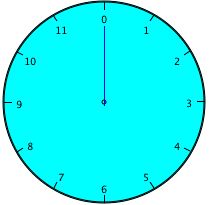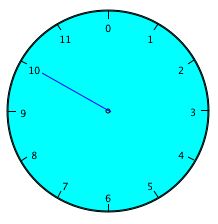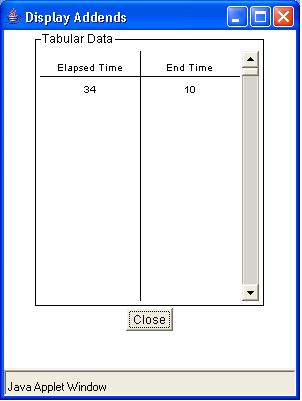What is Clock Arithmetic?
Clock time can be thought of as a type of modular arithmetic. Modular arithmetic is used when we only want to consider the first N natural numbers, for some finite number N. There are two cases to consider when we add or multiply numbers in this situation:
- When we add or multiply two numbers and the result is less than N, the final answer is just the number resulting from the addition or multiplication.
- When we add or multiply two numbers and the result is more than N, the final answer is found by thinking of the numbers as looping back to the beginning, i.e., N = 0, N + 1 = 1, N + 2 = 2, etc.
We can think of clocks this way. For our usual clock, we think of the typical dial, except with 12 = 0. So 13 hours after 0 o'clock is 1 o'clock (13 = 12+1 which is 1 on the dial).
A clock with 5 hours works the same way: 17 hours after 0 o'clock is 2 o'clock (17 = 5 + 12 = 10 + 7 = 15 + 2 which is 2 on the dial).
How Do I Use This Activity?
This activity can be used to explore modular arithmetic. The user sets a starting value and then moves the "clock" forward a number of specified hours to see the resulting sum. The activity also displays the number of times the "clock" passes the starting value.
Controls and Output
-
You can use the
scrollbar to modify the size of the clock. The clock's size ranges from 2 to 26. In the example
below, the current clock size is 12.

-
After you have set the clock to the size you want, you can enter the number of the hour of where you want the clock to start. This number can be anywhere between 0 and one less than the size of the clock. For example, if the clock size was 12, the starting time could range from 0 and 11. An example of entering a starting time of 0:

After you enter the starting time, press on the
 button. This will move the clock hand to the number you input:
button. This will move the clock hand to the number you input:

Also, the place where you entered the starting time should turn grey and will no longer be editable:

A message should then appear in the text field:

Use the animation drop down menu to select how quickly the clock is animated. Choose from fast, medium, and slow, or choose "Do not animate" if you want to see the result but not watch the animation.

-
To make the clock hand move, enter a number into the input for the elapsed time. This number must be between 0 and 1000. An example of entering an elapsed time of 34 hours is:

To make this change on the clock, press on the
 button. The hand moves forward on the clock the number of hours that you specified. An
example of a clock of size 12, which started on time 0 and moved 34 hours:
button. The hand moves forward on the clock the number of hours that you specified. An
example of a clock of size 12, which started on time 0 and moved 34 hours:

Also, a message appears in the text field. It gives the start time, the calculated time after the clock moves the elapsed time you specified, and the number of times the hand passed the starting time:

-
Another option in this applet is to display the addends. This gives a list of elapsed times
and end times. These can be viewed by clicking on the
 button. A pop-up window should appear:
button. A pop-up window should appear:
-
The
 button will return the clock hand to the initial zero position and allows you to enter in a
new starting time.
button will return the clock hand to the initial zero position and allows you to enter in a
new starting time.
Description
This activity allows the user to experiment with clock (modular) arithmetic. This activity would work well in mixed ability groups of two or three for about thirty minutes if you use the exploration questions and fifteen minutes otherwise.
Place in Mathematics Curriculum
This activity can be used to:
- practice students' long division skills
- motivate the ideas of modular arithmetic
Standards Addressed
Grade 3
-
Numeration
- The student demonstrates conceptual understanding of whole numbers up to one thousand.
Grade 4
-
Numeration
- The student demonstrates conceptual understanding of whole numbers to ten thousands.
Grade 5
-
Numeration
- The student demonstrates conceptual understanding of whole numbers to millions.
Grade 6
-
Estimation and Computation
- The student accurately solves problems (including real-world situations).
-
Numeration
- The student demonstrates conceptual understanding of fractions (proper or mixed numbers), decimals, percents (whole number), or integers.
Grade 7
-
Estimation and Computation
- The student accurately solves problems (including real-world situations).
Grade 8
-
Estimation and Computation
- The student accurately solves problems (including real-world situations).
Grade 9
-
Numeration
- The student demonstrates conceptual understanding of real numbers.
Grade 10
-
Numeration
- The student demonstrates conceptual understanding of real numbers.
Grade 4
-
Number Sense
- 1.0 Students understand the place value of whole numbers and decimals to two decimal places and how whole numbers and decimals relate to simple fractions. Students use the concepts of negative numbers
Grade 6
-
Number Sense
- 2.0 Students calculate and solve problems involving addition, subtraction, multiplication, and division
Third Grade
-
Number and Operations in Base Ten
- Use place value understanding and properties of operations to perform multi-digit arithmetic.
-
Operations and Algebraic Thinking
- Represent and solve problems involving multiplication and division.
- Understand properties of multiplication and the relationship between multiplication and division.
- Multiply and divide within 100.
Fourth Grade
-
Number and Operations in Base Ten
- Generalize place value understanding for multi-digit whole numbers.
- Use place value understanding and properties of operations to perform multi-digit arithmetic.
Fifth Grade
-
Number and Operations in Base Ten
- Understand the place value system.
Grades 3-5
-
Numbers and Operations
- Compute fluently and make reasonable estimates
Grades 6-8
-
Numbers and Operations
- Compute fluently and make reasonable estimates
Grades 9-12
-
Numbers and Operations
- Compute fluently and make reasonable estimates
- Understand numbers, ways of representing numbers, relationships among numbers, and number systems
Grade 6
-
Number and Operations, Measurement, Geometry, Data Analysis and Probability, Algebra
- COMPETENCY GOAL 1: The learner will understand and compute with rational numbers.
Grade 7
-
Number and Operations, Measurement, Geometry, Data Analysis and Probability, Algebra
- COMPETENCY GOAL 1: The learner will understand and compute with rational numbers.
Grade 8
-
Number and Operations, Measurement, Geometry, Data Analysis and Probability, Algebra
- COMPETENCY GOAL 1: The learner will understand and compute with real numbers.
5th Grade
-
Numbers and Operations
- The student will demonstrate through the mathematical processes an understanding of the place value system; the division of whole numbers; the addition and subtraction of decimals; the relationships among whole numbers, fractions, and decimals; and accurate, efficient, and generalizable methods of adding and subtracting fractions.
4th Grade
-
Number and Operations
- Standard 4-2: The student will demonstrate through the mathematical processes an understanding of decimal notation as an extension of the place-value system; the relationship between fractions and decimals; the multiplication of whole numbers; and accurate, efficient, and generalizable methods of dividing whole numbers, adding decimals, and subtracting decimals.
5th Grade
-
Number and Operation
- The student will develop number and operation sense needed to represent numbers and number relationships verbally, symbolically, and graphically and to compute fluently and make reasonable estimates in problem solving.
6th Grade
-
Number and Operation
- Content Standard 1.0 The student will develop number and operation sense needed to represent numbers and number relationships verbally, symbolically, and graphically and to compute fluently and make reasonable estimates in problem solving.
7th Grade
-
Number and Operation
- The student will develop number and operation sense needed to represent numbers and number relationships verbally, symbolically, and graphically and to compute fluently and make reasonable estimates in problem solving.
8th Grade
-
Number and Operation
- The student will develop number and operation sense needed to represent numbers and number relationships verbally, symbolically, and graphically and to compute fluently and make reasonable estimates in problem solving.
3rd Grade
-
Numbers and Operations
- The student will develop number and operation sense needed to represent numbers and number relationships verbally, symbolically, and graphically and to compute fluently and make reasonable estimates in problem solving.
4th Grade
-
Number and Operation
- The student will develop number and operation sense needed to represent numbers and number relationships verbally, symbolically, and graphically and to compute fluently and make reasonable estimates in problem solving.
Grade 3
-
Number, Operation, and Quantitative Reasoning
- 1. The student uses place value to communicate about increasingly large whole numbers in verbal and written form, including money.
- 3. The student adds and subtracts to solve meaningful problems involving whole numbers.
Grade 4
-
Number, Operation, and Quantitative Reasoning
- 1. The student uses place value to represent whole numbers and decimals.
Grade 5
-
Number, Operation, and Quantitative Reasoning
- 1. The student uses place value to represent whole numbers and decimals.
Grade 6
-
Number, Operation, and Quantitative Reasoning
- 2. The student adds, subtracts, multiplies, and divides to solve problems and justify solutions.
Grade 7
-
Number, Operation, and Quantitative Reasoning
- 2. The student adds, subtracts, multiplies, or divides to solve problems and justify solutions.
Grade 8
-
Number, Operation, and Quantitative Reasoning
- 2. The student selects and uses appropriate operations to solve problems and justify solutions.
Textbooks Aligned
6th
-
Module 5 - Creating Things
- Section 2: Customary Units of Length
Be Prepared to
- explain that not all people use a twelve hour clock.
- explain some of the benefits of military time.
